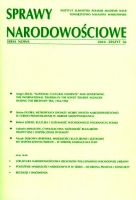Struktura narodowościowa regionów południowo-wschodniej Ukrainy
The ethnic structure of the territories of South-Eastern Ukraine
Author(s): Helena KrasowskaSubject(s): Cultural Essay, Political Essay, Societal Essay
Published by: Instytut Slawistyki Polskiej Akademii Nauk
Keywords: Ukraine; ethnic minorities; assimilation; multiculturalism
Summary/Abstract: In her article the author analyses ethnic differentiation in the Donetsk and Zaporozhe regions in South-Eastern Ukraine. These areas first were a target of colonisation in order to establish a new fuel-metallurgical basis for the Russian Empire by developing the Donetsk coal industry and strengthening agriculture by colonising the steppes near the Black and Azov Seas. An important stage in the settlement of these areas occurred at the beginning of the 16th century, when early settlers, mainly Ukrainian manufacturers, Cossacks and peasants-refugees, arrived. The next step came in the 16-18th centuries, when the defence of the southern borderland from Tartar invasions took place. From the 18th century onwards foreign newcomers contributed to the cultural and industrial development of this region. They settled mainly in compact groups. The characteristics of settlement and development of such groups as Bulgarians, Germans, Jews, Czechs, Tartars, Poles, and Armenians are analysed in this article, too. The population censuses of the years 1959, 1989, 2001 are taken into account. The industrialisation and later „Stalinisation” of the region led to the liquidation of part of some ethnic groups and to their enforced assimilation, in an effort which was supposed to create a homogeneous Soviet people. However, as a result of political changes since 1991, the region is becoming multicultural again.
Journal: Sprawy Narodowościowe
- Issue Year: 2010
- Issue No: 36
- Page Range: 189-201
- Page Count: 13
- Language: Polish

